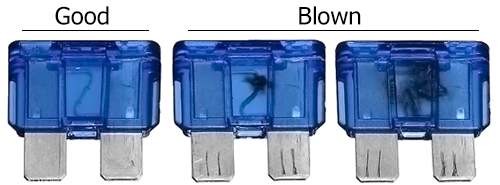Fuses serve as vital guardians of the vehicle’s electrical network, shielding it from short circuits and overload. These consumable elements, upon burning out, are replaced with ones of the same kind. It’s wise to always carry a set of spare fuses in your vehicle.
Checking fuses
The simplest way to see if a fuse has blown is through a visual inspection. If the metal conductor inside is damaged, the fuse has burnt out and must be replaced with an identical one (same type, color, and rating).
For ease of maintenance, fuses are organized into special blocks. Most cars have two fuse blocks – one under the hood and another inside or under the dashboard. However, configurations vary – some cars have only one block, or additional ones (like in the trunk). Knowing which fuse protects which device is crucial. The layout and purpose of fuses vary depending on the car’s model, year, region, and installed equipment. Our website has gathered detailed information about fuses and relays for many car models – including the location of all blocks, fuse diagrams, and a list of protected devices. Select your car’s make from the list below, then the model, or use the site’s search function to find information about fuses for your car.
Car Brands:
 Buick
Buick  Cadillac
Cadillac  Chevrolet
Chevrolet  Chrysler
Chrysler  Dodge
Dodge  Ford
Ford  GMC
GMC  Hummer
Hummer  Jeep
Jeep  Kia
Kia  Lexus
Lexus  Mitsubishi
Mitsubishi  Ram
Ram  Scion
Scion  Subaru
Subaru  Tesla
Tesla  Toyota
Toyota  Volkswagen
Volkswagen
Precautions when replacing fuses:
- Be careful when handling fuses. Ignoring safety measures or incorrect installation can lead to electric shock, short circuits, or fire.
- Always turn off the ignition and all equipment, and remove the key from the ignition lock before checking and replacing fuses. For high-amperage fuses, it’s advised to disconnect the battery (refer to your car’s manual for details).
- Never replace a burnt-out fuse with a higher-rated one, never repair fuses, and never substitute fuses with metal wire. Only use a fuse identical to the burnt-out one.
- Frequent fuse burnouts could indicate an electrical problem. If a replaced fuse burns out quickly again, seek professional service to diagnose and fix the issue.
- Keep fuse blocks clean, ensure their covers are correctly installed, and prevent moisture from entering the blocks.
- Choose only quality fuses for replacement. Low-quality ones may fail to function when needed or cause other damages, like overheating due to thin contacts, which can melt their housing in the block.